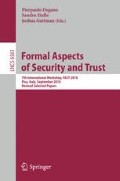Abstract
We introduce and give formal definitions of attack–defense trees. We argue that these trees are a simple, yet powerful tool to analyze complex security and privacy problems. Our formalization is generic in the sense that it supports different semantical approaches. We present several semantics for attack–defense trees along with usage scenarios, and we show how to evaluate attributes.
Access this chapter
Tax calculation will be finalised at checkout
Purchases are for personal use only
Preview
Unable to display preview. Download preview PDF.
References
Vesely, W.E., Goldberg, F.F., Roberts, N., Haasl, D.: Fault Tree Handbook. Technical Report NUREG-0492, U.S. Regulatory Commission (1981)
Schneier, B.: Attack Trees. Dr. Dobb’s Journal of Software Tools 24(12), 21–29 (1999)
Mauw, S., Oostdijk, M.: Foundations of Attack Trees. In: Won, D.H., Kim, S. (eds.) ICISC 2005. LNCS, vol. 3935, pp. 186–198. Springer, Heidelberg (2006)
Jürgenson, A., Willemson, J.: Serial Model for Attack Tree Computations. In: Lee, D., Hong, S. (eds.) ICISC 2009. LNCS, vol. 5984, pp. 118–128. Springer, Heidelberg (2010)
Edge, K.S., Dalton II, G.C., Raines, R.A., Mills, R.F.: Using Attack and Protection Trees to Analyze Threats and Defenses to Homeland Security. In: Military Communications Conference, MILCOM 2006, pp. 1–7. IEEE, Los Alamitos (2006)
Saini, V., Duan, Q., Paruchuri, V.: Threat Modeling Using Attack Trees. Journal of Computing in Small Colleges 23(4), 124–131 (2008)
Bistarelli, S., Fioravanti, F., Peretti, P.: Defense Trees for Economic Evaluation of Security Investments. In: ARES, pp. 416–423. IEEE Computer Society, Los Alamitos (2006)
Bistarelli, S., Dall’Aglio, M., Peretti, P.: Strategic Games on Defense Trees. In: Dimitrakos, T., Martinelli, F., Ryan, P.Y.A., Schneider, S. (eds.) FAST 2006. LNCS, vol. 4691, pp. 1–15. Springer, Heidelberg (2007)
Moore, A.P., Ellison, R.J., Linger, R.C.: Attack Modeling for Information Security and Survivability. Technical Report CMU/ SEI-2001-TN-001, CMU Software Eng (2001)
Cervesato, I., Meadows, C.: One Picture Is Worth a Dozen Connectives: A Fault-Tree Representation of NPATRL Security Requirements. IEEE Transactions on Dependable and Secure Computing 4, 216–227 (2007)
Amoroso, E.G.: Fundamentals of Computer Security Technology. Prentice-Hall, Inc., Upper Saddle River (1994)
Morais, A.N.P., Martins, E., Cavalli, A.R., Jimenez, W.: Security Protocol Testing Using Attack Trees. In: CSE (2), pp. 690–697. IEEE Computer Society, Los Alamitos (2009)
Sheyner, O., Haines, J.W., Jha, S., Lippmann, R., Wing, J.M.: Automated Generation and Analysis of Attack Graphs. In: IEEE Symposium on Security and Privacy, pp. 273–284. IEEE Computer Society, Los Alamitos (2002)
Bistarelli, S., Peretti, P., Trubitsyna, I.: Analyzing Security Scenarios Using Defence Trees and Answer Set Programming. Electronic Notes in Theoretical Computer Science 197(2), 121–129 (2008)
Kordy, B., Mauw, S., Melissen, M., Schweitzer, P.: Attack–defense trees and two-player binary zero-sum extensive form games are equivalent. In: Alpcan, T., Buttyán, L., Baras, J.S. (eds.) GameSec 2010. LNCS, vol. 6442, pp. 245–256. Springer, Heidelberg (2010)
Rehák, M., Staab, E., Fusenig, V., Pěchouček, M., Grill, M., Stiborek, J., Bartoš, K., Engel, T.: Runtime Monitoring and Dynamic Reconfiguration for Intrusion Detection Systems. In: Kirda, E., Jha, S., Balzarotti, D. (eds.) RAID 2009. LNCS, vol. 5758, pp. 61–80. Springer, Heidelberg (2009)
Doets, K.: Basic Model Theory. CSLI Publications, Stanford (1996)
Jürgenson, A., Willemson, J.: Computing Exact Outcomes of Multi-parameter Attack Trees. In: Chung, S. (ed.) OTM 2008, Part II. LNCS, vol. 5332, pp. 1036–1051. Springer, Heidelberg (2008)
Amenaza: SecurITree, http://www.amenaza.com/
Isograph: AttackTree+, http://www.isograph-software.com/atpover.htm
Author information
Authors and Affiliations
Editor information
Editors and Affiliations
Rights and permissions
Copyright information
© 2011 Springer-Verlag Berlin Heidelberg
About this paper
Cite this paper
Kordy, B., Mauw, S., Radomirović, S., Schweitzer, P. (2011). Foundations of Attack–Defense Trees. In: Degano, P., Etalle, S., Guttman, J. (eds) Formal Aspects of Security and Trust. FAST 2010. Lecture Notes in Computer Science, vol 6561. Springer, Berlin, Heidelberg. https://doi.org/10.1007/978-3-642-19751-2_6
Download citation
DOI: https://doi.org/10.1007/978-3-642-19751-2_6
Publisher Name: Springer, Berlin, Heidelberg
Print ISBN: 978-3-642-19750-5
Online ISBN: 978-3-642-19751-2
eBook Packages: Computer ScienceComputer Science (R0)

